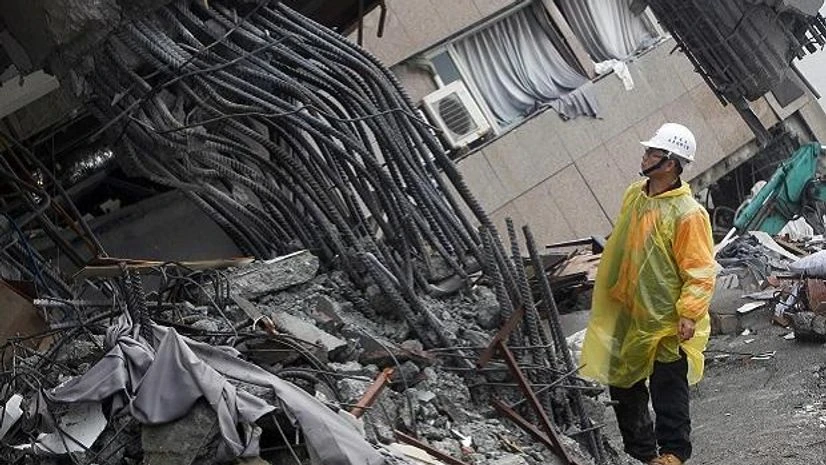If a large magnitude earthquake occurs in the near future in the northwest (NW) Himalayas region as predicted by a recent study, the National Capital Region (NCR) of Delhi would suffer very heavy damage.
The 2001 earthquake in Bhuj in Gujarat, which claimed about 10,000 lives, had shown that the destruction by an earthquake is caused by two different types of waves: Shear Waves, confined to about 70 to 100 km from the epicentre and which adversely affect the foundations and basements of structures; and Rayleigh Waves that travel with a velocity between 2.5 to 3 km per second and produce a different type of destructive effect.
These Rayleigh Waves from earthquakes of magnitude above 7.5 become active at a distance beyond 150 to 200 km or more from the epicentre and adversely affect tall structures (height more than 17 meters) as was observed at Ahmedabad city located at a distance of about 320 km from the Bhuj earthquake's epicentre. Another very important observation was that all structures with "stilted" floors (where the ground floor is used for vehicle parking) were severely damaged. A similar damaging effect by Rayleigh waves was observed in Mexico City, located about 500 km from the epicentre of the 1985 earthquake.
The Himalayan states had been visited by a number of large magnitude earthquakes and a recent study suggests the NW region (mostly Uttarakhand, Himachal Pradesh and parts of Kashmir) is ripe for one. The Delhi NCR escaped major damage from the destructive Rayleigh Waves from past earthquakes because, prior to 1950, there were no high rise buildings there.
But the situation is now different. With its satellite townships of Noida, Greater Noida, Gurugram, Ghaziabad and Faridabad, NCR Delhi forms a big cluster of high-rise buildings with flyovers, bridges and elevated roads. It is also known that some of the high-rise structures have collapsed during construction itself. Many high-rise buildings have stilted floors. As was witnessed in Ahmedabad after the Bhuj earthquake, all these structures could suffer heavy damage in case of a large magnitude earthquake in the NW Himalayan region with its epicentre in the range of 270 to 350 km from NCR Delhi.
The Himalayan fault is known to have a potential to generate earthquakes up to a magnitude of 8 or more. The foundations in Delhi are not on solid rock but there is excess of soil and crushed rock (murrum) on the ground. In case of a powerful earthquake in the Himalayas, the long scissors of Rayleigh Waves could wildly chop the tall concrete structures in Delhi and neighbouring areas. The possibility that these buildings may collapse like a pack of cards in "Ahmedabad Fashion" cannot be ruled out.
In the opinion of some international expert seismologists, the world could see an increase in the number of strong earthquakes in 2018 and the next few years due to the periodic slowing of the Earth's rotation. There is a clear correlation between the speed of the earth's rotation and global earthquake activity, said Roger Billham of the University of Colorado and Rebecca Bendick of the University of Montana, who recently presented their research at a conference in the US.
More From This Section
Fluctuations in the Earth's rotation are tiny -- changing the length of the day by several milliseconds -- but could be enough to release vast amounts of underground energy, they have said. It has been reported that on five occasions in the past century, a 25-30 percent increase in annual number of earthquakes (of magnitude 7 or greater) coincided with a slowing in the mean rotation velocity of the Earth.
The slowing down of Length of Day (LoD) normally lasts for six years, after which the earth enters a period of enhanced seismicity. In this century, the LoD started in 2011 and now the year 2018 could be considered a period of higher seismic activity. While the research did not indicate precisely when and where these future earthquakes will occur, it showed that most of the intense earthquakes that responded to changes in day length seemed to occur near the equator.
A destructive earthquake is an extreme geophysical event and 2018 had already been witness to some climatic and atmospheric extremities. These include no water in Johannesburg and to some extent in Rio de Janeiro; thermal high of 48.2 degrees (C) in Churu (Rajasthan) and Gadchiroli (Maharashtra); and an all-time high value (45 degree C) in Vancouver (Canada) that claimed 28 lives. It has also been a record year of snowfall in Europe, America and China-Japan, with 20 causalities.
Currently, Himachal Pradesh and Uttarakhand in India are experiencing heavy snowfall up to about 1-1.5 meters. The year 2018 also appears to be an extremity as far as air accidents go. Until June, there were four accidents in Havana (Cuba), Algeria, Kathmandu (Nepal) and Moscow (Russia) together taking 488 lives.
Considering the expert opinions accounting for climatic and atmospheric extremities and keeping in view the reduction in the length of day due to slowing down of earth rotation, it could be assumed that the predicted large magnitude earthquake in the Himalayas could occur most probably in 2018 or its proximity.
(Arun Bapat is a research seismologist and former chief of earthquake research at the Central Water and Power Research Station in Pune. The views expressed are personal. He can be contacted at arunbapateq@gmail.com)
--IANS
arunb/vm/tb

)
